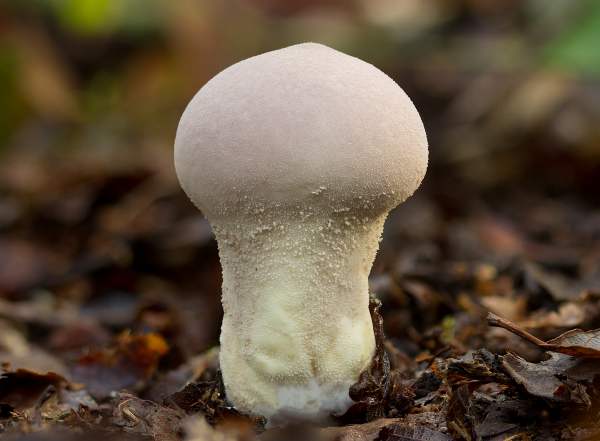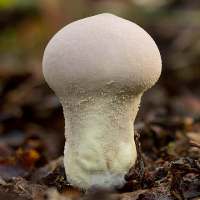Lycoperdon mammiforme Pers. - Flaky Puffball
Phylum: Basidiomycota - Class: Agaricomycetes - Order: Agaricales - Family: Agaricaceae
Distribution - Taxonomic History - Etymology - Identification - Culinary Notes - Reference Sources

Lycoperdon mammiforme, the Flaky Puffball, is a rare find. Most puffballs are edible when young, but some experts state that the Flaky Puffball is inedible and possibly poisonous. In any case because of their scarcity picking these puffballs is not recommended.
Formerly grouped together with other ball or 'stomach fungi' including earthstars and earthballs, puffballs (many edible) are now accepted as close relatives to (also edible) Field Mushrooms.
With age the Flaky Puffball loses its flakes and turns brown, eventually splitting open when the spores are ripe.
Distribution
An uncommon find in Britain and Ireland, the Flaky Puffball is widespread but localised across most of mainland Europe; they are particularly common in parts of central France, but I have seen them on woodland edges as far east as Bulgaria.
Taxonomic history
This largish edible fungus was first described in scientific literature by Christiaan Hendrik Persoon in 1801, when it was given the binomial name Lycoperdon mammiforme.
Synonyms of Lycoperdon mammiforme include Lycoperdon velatum Vittad.
Etymology
The specific epithet mammiforme simply means 'shaped like a breast' (indicating why one of its formerly popular common names is the Venus Puffball), while the genus name Lycoperdon literally means 'wolf's flatulence' and begs the question who got close enough to a wolf to become an expert on the matter. For most of us, surely such an odour cannot be considered a particularly helpful diagnostic feature for identifying the Flaky Puffball, Lycoperdon mammiforme.
Identification guide
 |
FruitbodyPear shaped, surface background pale pinkish when young, covered in pale woolly patches that fall away to reveal a smooth buff-pink surface as fruitbody matures; spores are released via an apical pore that opens at maturity; 3 to 5cm across, and 3 to 6cm tall; rudimentary infertile stem paler than the fertile upper chamber (peridium); gleba white and firm at first becoming olive brown and powdery. |
SporesSpherical, minutely spiny, 3.5-4.5µm in diameter . Spore massChocolate-brown. |
|
Odour/taste |
Not distinctive. |
Habitat & Ecological role |
Found on alkaline sites in beech woodlands and in grass on woodland edges. |
Season |
July to November in Britain and Ireland. |
Similar species |
Lycoperdon echinatum is darker, with a reddish tinge, and is covered in spines. Lycoperdon perlatum is white and covered in pearly warts. |
Culinary notes
Lycoperdon mammiforme is not one of the 'Magnificent Seven' edible fungi featured in chapter 10 of Fascinated by Fungi, but this rare edible mushroom would probably make a very good meal if prepared and cooked properly; however, in view of its rarity collection of Flaky Puffballs for the pot is inappropriate..
For a very easy to recognise edible puffball that cannot be mistaken for any other mushroom, see Calvatia gigantea, the Giant Puffball. Unfortunately it's not every day that you stumble across Giant Puffballs, as they are not only uncommon but also very localised in their distribution. If you find a good spot for these mighty meaty meal sources, make a note of it because Giant Puffballs, like Common Puffballs, usually reappear in the same places for many years.
Reference Sources
Fascinated by Fungi, 2nd Edition, Pat O'Reilly 2016, reprinted by Coch-y-bonddu Books in 2022.
Pegler, D.N., Laessoe, T. & Spooner, B.M (1995). British Puffballs, Earthstars and Stinkhorns. Royal Botanic Gardens, Kew.
Dictionary of the Fungi; Paul M. Kirk, Paul F. Cannon, David W. Minter and J. A. Stalpers; CABI, 2008
Taxonomic history and synonym information on these pages is drawn from many sources but in particular from the British Mycological Society's GB Checklist of Fungi.
Acknowledgements
This page includes pictures kindly contributed by David Kelly.
Fascinated by Fungi. Back by popular demand, Pat O'Reilly's best-selling 450-page hardback book is available now. The latest second edition was republished with a sparkling new cover design in September 2022 by Coch-y-Bonddu Books. Full details and copies are available from the publisher's online bookshop...

